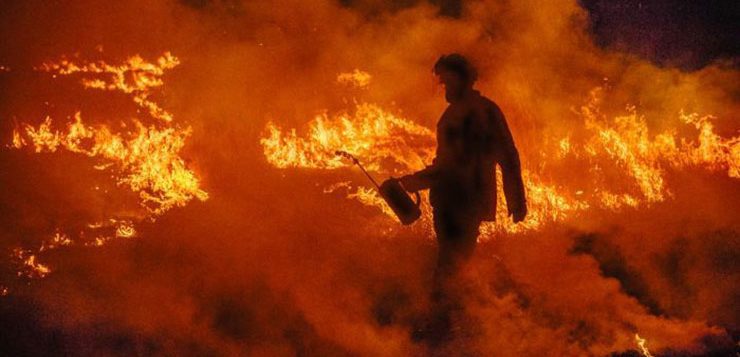DON’T MISS ANYTHING! ONE CLICK TO GET NEW MATILDA DELIVERED DIRECT TO YOUR INBOX, FREE!
As parts of Queensland NSW burn, Dr Richard Hil – who lives in the path of one of the fires – wonders why so little is being done when so much is at risk.
Over the weekend, I sat in the passenger seat of a car peering into a thick blanket of smoke that stretched all the way from Bellingen to Mullumbimby in NSW. It didn’t let up.
It reminded me of English pea-soup fog, the main difference being that its wasn’t fog, and it smelt an awful lot like burning wood.
That’s precisely what it was.
Vast tracts of NSW and Queensland were burning, and continue to burn. Houses and businesses have been lost. Millions of animals have perished. Landscapes charred. Tens of thousands of people have been traumatised.
As I write, the burning is being fanned by high winds, and there’s lots more record-busting heat, wind and fire to come. The area around Tenterfield, which has experienced years of drought, was ablaze, this on top of catastrophic blazes last year which destroyed around 20 houses.
Sadly, such scenes are becoming commonplace. And when they occur, we’re fed the same ritual: the news headlines, the briefings, the warnings, and the stories of heroism and destruction.
We’re told that this or that event shouldn’t be happening at this time of year, that they’re unusual, unprecedented etc. We’re urged to be constantly vigilant, to get to know our fire drills.
Meanwhile, as I stare out of my window in Mullumbimby, the wind is gathering strength, the smoke has thinned, but there are bits of debris whirling around our house. It feels eerie, ominous.
I know there’s a fire up the road. It’s contained, apparently. I’d better check. My nerves are a tad frayed. The sun has taken on an odd hue: more orange than yellow: huge and misty, but still very hot. I keep peering out of the window, I can’t help myself.
Earlier I popped into town and could overhear animated conversations about the fires. I dropped into my favourite café, where a gaggle of dedicated climate watchers were talking about the fires as evidence “of the sixth extinction”.
Nobody was laughing. Hyperbole? It didn’t sound like it. A mate of mine was urging others to “connect the dots”: massive storms in the Atlantic and in Japan, floods in Africa, droughts, and fires all over the shop.
These days, the climate/ecological crisis is the subject of routine conversations, directed in part by the regular occurrence of extreme weather events. Survey after survey say much the same – that people are very worried about “climate change”. They should be. The crisis no longer feels remote or confined to the future. It’s here and now. Many of us are seeking to come to terms with what is happening, in whichever way we can.
Many have accepted some form of finality. I’ve heard heaps of people saying “we’re fucked” or that, minimally, we can’t assume anything anymore – certainly not predictable weather and safety and security.
They remain politically active but consider extinction as an imminent possibility.
Others refuse to think like this, and insist there’s hope if we act now.
There’s nothing new about such orientations. They’ve been around for decades. My friends remind me that we’ve been on the cusp of environmental disaster (of various sorts) for yonks. But there’s something profoundly different about the current crisis.
The exponential rate of change, the feedback loops, the frequency and severity of extreme weather events, and the destruction of biodiversity are disturbingly new, as is the level of greenhouse gasses in the atmosphere.
Many scientists are in states of despair, their repeated warnings ignored. But still, our own government dances around the crisis, using clever accounting tricks to adjust its emissions records.
The banks are still lending money to fossil fuel companies, coal mines and gas fields are being constructed, and the premiers of NSW and Queensland, among others, are still encouraging land clearing and fossil fuel production while at the same time standing in front of the TV cameras to offer support to the victims of droughts and bushfires.
This is cynicism on a grand scale. But it’s more than that: it’s really complicit, calculated violence that seeks to massage public opinion with drivel abbot ‘climate action’ while encouraging practices that do the very opposite.
These ‘leaders’ are in the same mould as NewsCorp boss Rupert Murdoch and former CEO of Exon Mobil Rex Tillson, who have known full well the implications of the climate/ecological emergency but who carry on regardless with business-as-usual.
Meanwhile, the ABC and other media outlets reporting on the fires make no reference to the climate/ecological crisis, as if it has no connection to current events.
This extraordinary self-censorship reflects a political culture in which climate cynics – many on the government benches – have politicised the emergency to a point where it simply can’t be mentioned by the national broadcaster.
But make no mistake: this is violent silence that reinforces a narrative whose effects are palpable. It allows policy makers to downplay the impact of the climate/ecological crisis, to fudge real action, to put people’s lives and the security of the nation, and indeed the entire world, at risk.
Those responsible for this violence in a time of crisis should be held to account.
DON’T MISS ANYTHING! ONE CLICK TO GET NEW MATILDA DELIVERED DIRECT TO YOUR INBOX, FREE!
Donate To New Matilda
New Matilda is a small, independent media outlet. We survive through reader contributions, and never losing a lawsuit. If you got something from this article, giving something back helps us to continue speaking truth to power. Every little bit counts.




